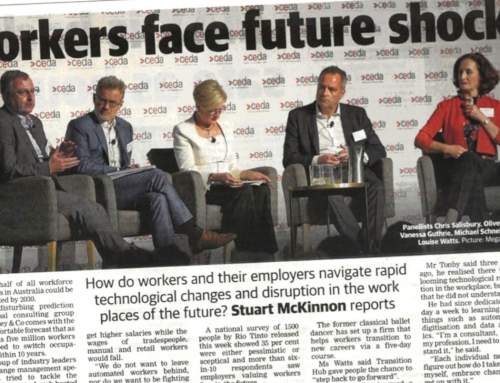In the face of the COVID19 crisis in Italy skilled innovators brought their skills to the aid of the health care system and in the process disrupted the incumbent supplier who failed to see the situation from the client’s perspective.
Disruption is, for many, a dirty word that strikes fear into the hearts of business leaders. These leaders have worked hard building a competitive offering, overcoming problem after problem to develop a solution that the market values and then ‘boom,’ a left of field innovation/start-up/pivot/lean/agile sucker-punch-hits.
Often technology or business model-driven disruption arrives in a form that those being disrupted refuse to alter their mindset to accommodate the new way of doing things and herein lies their undoing. Think of London’s Black Cab drivers’ blockade of streets of England’s capital, simultaneously protesting and highlighting the arrival of the rideshare tsunami.
While it’s easy to see disruption in a negative light, it’s often our perspective that needs to pivot rather than our business model.
In 2017 I was asked to explore innovations that would lead to reduced impact from unplanned downtime in a client’s operation. In part the project identified the potential for 3-D (metal) printing to expedite the replacement of parts in machinery to both, minimise the need to keep stock (spare parts) on hand, and also drastically reduce downtime in their operation. We identified innovative offerings that would allow the 3-D metal printing and set about validating the technical aspects and economics of the approach.
One of the main challenges was the supplier (designer and patent holder) of the machinery in question. They saw this situation as a loss. In their mind if the client’s machines, now out of warranty, didn’t need the supplier to provide consumables in the form of spare parts as their long-tail revenue would dry up. They set out to stop us at every turn. We offered to compensate them by paying royalties on each printed part that exceeded that generated by selling our client the part. After all, the cost of the parts wasn’t our focus, we were simply seeking increased uptime and greater responsiveness to interruptions in the client’s business. The supplier couldn’t see this from their client’s perspective and the opportunity became grid locked. The client then moved on to other focus areas. Ultimately this supplier’s attitude will lead to a strained relationship and the loss of reputation and future sales.
This week an eerily familiar story is playing out in Italy at the centre of Europe’s COVID-19. In the city of Brescia in Northern Italy a hospital has been saving lives using 3-D printed valves in oxygenation devices in their intensive care units to allow patients to live through the infection long enough for their antibodies to fight it. The local hospital urgently needed valves for an intensive care device which the supplier could not provide fast enough to keep things running. Running out of the valves may have had fatal repercussions for come patients. So the editor of the local newspaper Giornale di Brescia reached out to an associate, Massimo Temporelli, founder of The FabLab in Milan who is active in innovation centred on Industry 4.0 and 3-D printing in Italy. The Nunzia Vallini editor asked if it would be possible to 3D print replacement valves. FabLab went to work and bought in local partners from 3D printing firm, Isinnova. Isinnova brought a 3-D printer directly to the hospital and, in just a few hours, redesigned and then produced the missing piece.
Subsequently another local supplier, Lonati SpA, was found to 3D print additional valves, using a polymer laser powder bed fusion process.
Innovation and compassion saved the day.
Disappointingly it seems the original supplier was not happy with the above and refused to provide 3-D files in order to speed up the work. As I said… sounds eerily familiar, but with much more at risk.
Interestingly there is a global network of 3-D printing innovation warriors who are taking up the challenge in this area and bringing their substantial skills to the need for medical devices and ventilators in the face of the COVID19 onslaught.
Ultimately in these stories the disrupted incumbents could have protected their valuable client relationships and their position of power in the supply chain by focusing on the client’s needs. In the Italian story they also could have shown compassion and preserved their humanity by seeing the potential disruption as an opportunity to generate more value through enhancing a client’s business. Alas, the short-sightedness of their approach as cost them dearly. A true innovation led business would have recognised the high-value activity is in the design of the overall solution and the creation (design and manufacture) of a machine that serves a valuable purchase. I’m guessing the area of designing state-of-the-art ICU ventilation machines is rarefied indeed and that building a business around the production of consumable rubber valves or industrial metal parts relegates them to a commodity business which is destined to experience the negative side of disruption.
While disruption may strike fear in the hearts of business leaders, regardless of the industry if 2020 has taught us anything it’s that disruption is right around the corner. Those who embrace disruption and focus on the best solution for their clients are the ones that will remain competitive and in the market. Innovation and compassion saved the day for Italy and I am positive we will hear many of these stories in the coming months.
UPDATE: It seems the original manufacturer sells the part now being reproduced for less than $1 for about 10,000 euro and has engaged their lawyers to prevent the 3D printed alternative being used. https://www.techdirt.com/articles/20200317/04381644114/volunteers-3d-print-unobtainable-11000-valve-1-to-keep-covid-19-patients-alive-original-manufacturer-threatens-to-sue.shtml
Acknowledgements:
- I first became aware of this story through the twitter account of US tech mobility journalist Michal Naka (http://twitter.com/michalnaka)
- https://www.theguardian.com/technology/2016/feb/10/black-cab-drivers-uber-protest-london-traffic-standstill
- https://www.cnbc.com/2014/06/11/uber-striking-cab-drivers-are-undermining-legal-process.html
- https://www.projectopenair.org/
- http://usairproject.com/




